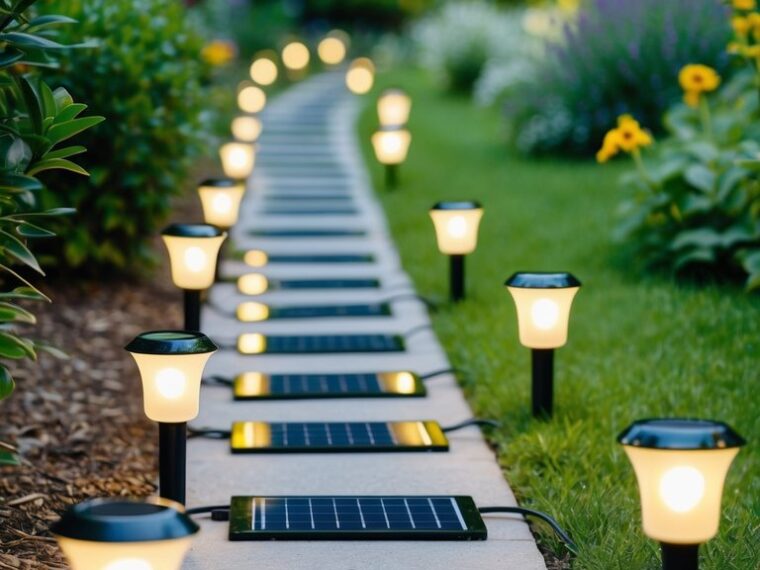Pathway lighting isn’t just about visibility—it’s about transforming your outdoor space into a safe, stylish, and welcoming environment. Whether you’re looking to boost security, highlight your landscaping, or make your evening strolls more pleasant, the right lighting can make all the difference.
This guide will walk you through the essentials of pathway lighting and help you choose the best options for your needs, all while keeping things simple and enjoyable.
Why Pathway Lighting Matters
Lighting your walkways is more than just a practical move. Here’s why it’s worth your attention:
- Improves Safety: Clearly lit paths reduce the risk of tripping or stumbling in the dark.
- Adds Curb Appeal: Thoughtfully placed lights can dramatically enhance your home’s exterior appearance.
- Sets the Mood: The right lighting creates a warm, inviting atmosphere for relaxing evenings or entertaining guests.
- Increases Security: Well-lit areas can deter unwanted visitors or animals from approaching your property.
Now that you understand why it’s important, let’s dive into your options.
Solar-Powered Lights: A Hassle-Free Favorite
If you’re looking for a low-maintenance, energy-efficient solution, solar-powered lights are a great place to start.
How They Work
These lights soak up sunlight during the day and automatically switch on when it gets dark. No cords, no plugs—just a clean and simple setup.
Benefits
- No Wiring Required: Just stick them in the ground and you’re done.
- Energy Efficient: Runs entirely on solar power, so there’s no added cost to your electric bill.
- Variety of Styles: From sleek modern looks to rustic lantern designs, there’s something to match every aesthetic.
- Automatic Operation: Most turn on and off without any manual effort.
What to Consider
- Make sure they get enough direct sunlight during the day.
- Choose durable models made from weather-resistant materials.
Downlighting: Soft, Subtle Illumination
If you’re aiming for a more natural glow that mimics moonlight, downlighting might be your go-to option.
What Is Downlighting?
This method involves placing lights above the pathway—either mounted on walls, trees, or posts—so the light shines downward.
Why Choose It?
- Creates a Gentle Glow: The light is more diffused and less harsh than ground-level lights.
- Reduces Glare: Especially helpful for walkways near gardens or patios where soft lighting is preferred.
- Adds Depth: Shadows cast by trees or plants can enhance the visual interest of your landscape.
Tips for Success
- Use warm-toned bulbs for a cozy, inviting feel.
- Space lights evenly for consistent coverage.
- Make sure fixtures are shielded to avoid light pollution.
Mixing Function and Style: Decorative Fixtures
Just because a light is functional doesn’t mean it can’t be attractive. Decorative pathway lights can serve both purposes at once.
Options to Explore
- Lantern-style Fixtures: Offer a charming, classic look.
- Bollard Lights: Short, sturdy posts that can provide more focused lighting.
- Stake Lights: Simple, flexible, and easy to reposition as needed.
How to Match Your Style
- Choose finishes that complement your home’s architecture.
- Stick to a consistent theme across all outdoor lighting.
- Mix heights and shapes carefully for visual interest without clutter.
Strategic Placement: Getting It Right
Good lighting isn’t just about the fixtures—it’s about where and how you place them.
Best Practices
- Focus on Key Areas: Light up paths, steps, and entrances first.
- Avoid Overcrowding: Too many lights can feel overwhelming.
- Highlight Landscaping: Use lights to draw attention to your favorite trees, shrubs, or flower beds.
- Create a Flow: Place lights in a way that gently guides visitors from one area to another.
Common Mistakes to Avoid
- Using lights that are too bright.
- Forgetting to shield bulbs, which can cause glare.
- Placing lights in spots where they can easily be damaged or blocked.
Choosing the Right Bulbs
Not all bulbs are created equal. Picking the right type can save you money and enhance your space.
LED vs. Halogen
- LED Bulbs: Energy-efficient, long-lasting, and available in a variety of color temperatures.
- Halogen Bulbs: Brighter, but they use more energy and have a shorter lifespan.
Warm or Cool Light?
- Warm White (2700K–3000K): Ideal for cozy, inviting pathways.
- Cool White (3500K–4100K): Good for more modern, high-visibility needs.
Maintenance Tips: Keep Things Glowing
Even the best lighting setup won’t last long without a bit of upkeep.
What You Should Do Regularly
- Clean the Fixtures: Dirt and debris can dim your lights.
- Check for Damage: Look out for cracked lenses, loose wires, or corrosion.
- Replace Batteries in Solar Lights: Most need a new battery every year or so.
- Trim Plants Around Fixtures: Ensure light isn’t blocked by overgrown foliage.
Planning Ahead: Design Like a Pro
Before you start installing, sketch out a basic lighting plan. Think about how you use your yard at night and where lighting would make the most impact.
Quick Design Tips
- Walk your yard after sunset to spot dark areas.
- Take notes on where lights should go for both safety and visual effect.
- Start small—you can always add more fixtures later.
Wrapping Up: Light the Way Forward
Pathway lighting is one of the simplest upgrades you can make to your outdoor space, but its impact is big. It’s about more than just seeing where you’re going—it’s about creating a space that feels welcoming, looks beautiful, and keeps you and your guests safe.
Ready to Transform Your Outdoor Space?
Now that you know the basics of pathway lighting—from solar options to design strategies—you’re ready to take your yard to the next level.
Take the first step today: Pick a few key spots in your outdoor area and choose a lighting style that fits your taste and needs. Whether it’s a quiet garden path or your front walkway, a little light goes a long way.
And if you found this guide helpful, don’t forget to share it with friends or bookmark it for later. More outdoor lighting tips and ideas are just a click away.




